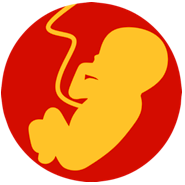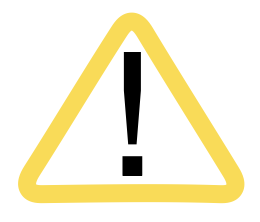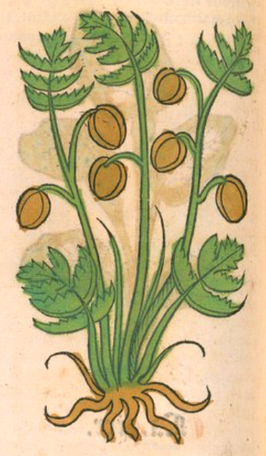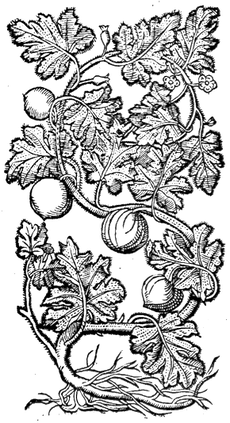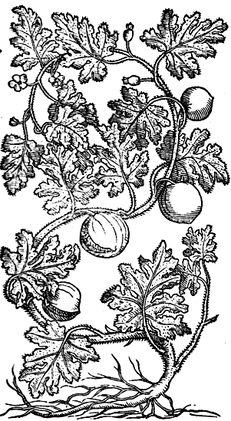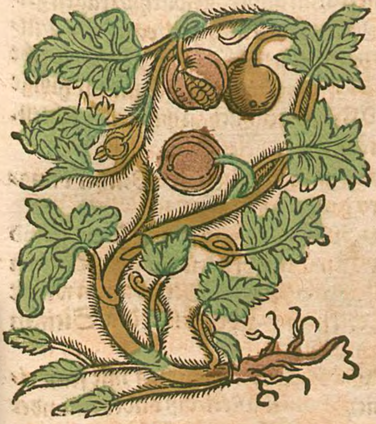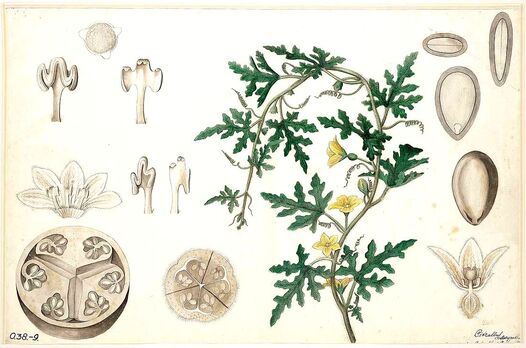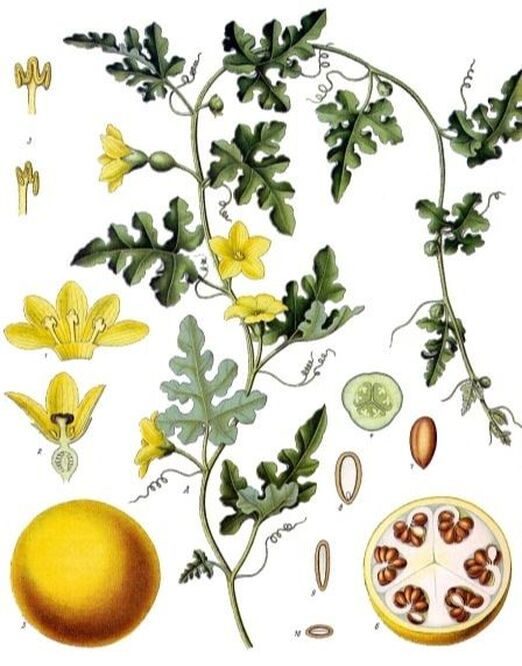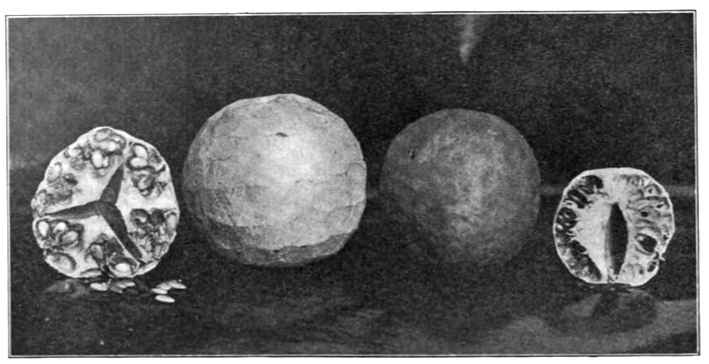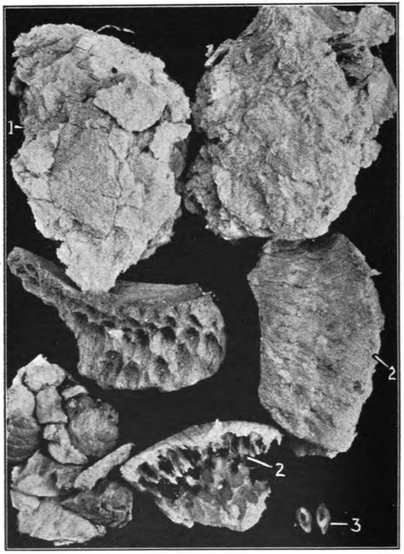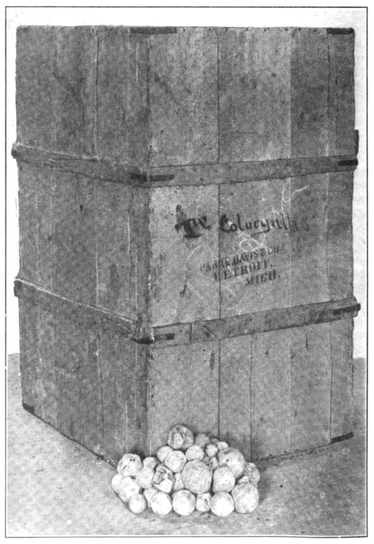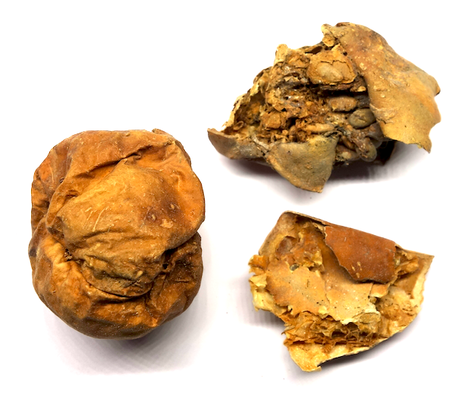Sentry Page Protection
Ortus Sanitatis, Meydenbach, 1491
|
Mesue, Opera de Medica, 1589
|
Della Materia Medicinale, Andrea Valuassori, 1562
|
Krauterbuch, Lonitzer, 1578
Botanische wandplaten, 1904–1914
(Köhler's Medizinal Pflanzen, 1897)
Colocynth fruit (Culcutta Unani College, Adam, 2019)
Botanical name:
Citrullus colocynthus (syn. Cucumis colocynthis)
Parts used:
Dried pulp of the fruit; Root
"Colocynth is of two kinds (a) male and (b) female. The male is fibrous and female is flabby, white and soft. The best kind of Colocynth is exceedingly white while the black as well as the hard varieties are inferior. When the pulp of Colocynth is to be extracted, the fruits must not be plucked from the plant but should be left as such, otherwise the pulp would become weak (in efficacy). The pulp should also be not collected unless the fruit becomes completely yellow leaving no trace of green colour, as otherwise it might be harmful, inferior in quality and fatal". (Avicenna)
Temperature & Taste:
Hot, dry. Bitter, toxic
"Hot and Dry in the Second degree". (Avicenna)
Classification:
2F. PURIFYING 2G. CLEANSING
3K. EXPECTORANT
Preparers and Purgers of Phlegm
Preparers and Purgers of Bile
Preparers and Purgers of Melancholy
Citrullus colocynthus (syn. Cucumis colocynthis)
Parts used:
Dried pulp of the fruit; Root
"Colocynth is of two kinds (a) male and (b) female. The male is fibrous and female is flabby, white and soft. The best kind of Colocynth is exceedingly white while the black as well as the hard varieties are inferior. When the pulp of Colocynth is to be extracted, the fruits must not be plucked from the plant but should be left as such, otherwise the pulp would become weak (in efficacy). The pulp should also be not collected unless the fruit becomes completely yellow leaving no trace of green colour, as otherwise it might be harmful, inferior in quality and fatal". (Avicenna)
Temperature & Taste:
Hot, dry. Bitter, toxic
"Hot and Dry in the Second degree". (Avicenna)
Classification:
2F. PURIFYING 2G. CLEANSING
3K. EXPECTORANT
Preparers and Purgers of Phlegm
Preparers and Purgers of Bile
Preparers and Purgers of Melancholy
Uses:
1. Strongly Purges Water and Phlegm:
-hydrogogue cathartic; promotes passage of water via the bowels in full doses, but was otherwise used to potentiate more gentle purgative medicines in formula, which was by far the most common use.
-purges Bile and Phlegm; Purges Damp and Cold Phlegm from deep and remote parts, from the Brain, Nerves, Joints, Lungs
-Edema, Ascites; damp diseases of the Joints. Purges in all Damp and Watery diseases
-Fruit has been used in Jaundice
-"The root of Colocynth is good for treating Dropsy" (Avicenna)
-"It purges thick phlegm and bilious humours out of Joints and particularly, the Nerves". (Avicenna)
2. Clears Cold Phlegm, Stops Wheezing:
-Cough, Asthma with excess Cold Phlegm; also Pleurisy
-Dioscorides especially recommended it for Difficulty Breathing; Avicenna praised it similarly.
3. Drastically Promotes Menstruation:
-promotes Menstruation, which it does strongly.
-in ancient times a pessary to Terminate a Pregnancy.
4. Clears the Head, Guides Downward
-chronic and one-sided Headache, Epilepsy, Apoplexy, Vertigo, and dimness of Sight, but only in strong bodies.
-seeds were used to prevent the hair from greying
-"Colocynth cleanses the brain". (Avicenna)
5. Resists Poison:
-"The root of Colocynth] is useful in Snake-bite and highly useful in Scorpion sting". (Avicenna)
6. Emetic:
-classically used to promote Vomit, taken in oil
-not used like this today
7. Externally:
-the fruit pulp is applied to Varicose Veins and Hemorrhoids.
-root paste is applied to Inflammations and Swellings
-"Colocynth is used as a massage in case of Leprosy and Elephantiasis". (Avicenna)
-cataplasm of the leaf is applied to Migraine and Neuralgia.
-topically for Tinbnitus
-Galen applied it topically to Sciatica
-"useful in Neuralgia, Arthralgia, Sciatica and cold gGout. Fresh Colocynth is plastered on Sciatica". (Avicenna)
Dose:
1. Usually only used in Powders, Pills and Troches.
2. Of its use in the form of Troches (see below) it was said 'and it is evident from long Experience that it is entirely free from Danger, when given seasonably and in a proper Dose'. The Troches were commonly used wherever Colocynth was ordered in a formula. (A Treatise on Foreign Drugs, Geoffroy and Thicknesse, 1749)
3. When infused or decocted it is very important to strain it through cloth to remove any irritant particles.
4. An extract prepared with Brandy purges less than the pulp in substance. (A Treatise on Foreign Drugs, Geoffroy and Thicknesse, 1749)
Of Colocynth in Pills and Powders: 500mg–2 grams (7 grains–1 scruple)
Correctives:
1. Tragacanth; Mastic; Almond oil (Unan)
2. "For the improvement of its quality and removing its harmful effects, mixing of gum Tragacanth is preferred to (Arabic) Gum because the latter suppresses the potency of the drug". (Avicenna)
Substitutes:
1. Aloe
2. Scammony; Ipomoea hederacea
3. Castor oil (Unani)
Preparation:
1. Prepared Colocynth:
"Sometimes, it is made hollow and stuffed with the rob [thickened juice] of Grapes or old and sweet Wine and left thus for a day and night". (Avicenna)
Afterwards, it is dried for use. This moderates its nature.
2. Roasted Colocynth:
"Sometimes it is placed on hot ashes till it warms up fully and then is taken orally". (Avicenna)
This means roasting gently on ashes, then cooling, drying and powdering finely. This moderates its action.
3. Honey prepared Colocynth
"The male and fibrous kind of Colocynth is stronger than its female and flabby kind. It must be powdered thoroughy and one should never be mistaken about it because even if a small perceptible particle is left unpowdered and mixed with gastric juices, it would develop wound and spread it around the stomach and the flexures of the intestines causing inflammation. It is, therefore, essential that first of all Colocynth must be soaked in honey-water and then dried and powdered." (Avicenna)
1. Usually only used in Powders, Pills and Troches.
2. Of its use in the form of Troches (see below) it was said 'and it is evident from long Experience that it is entirely free from Danger, when given seasonably and in a proper Dose'. The Troches were commonly used wherever Colocynth was ordered in a formula. (A Treatise on Foreign Drugs, Geoffroy and Thicknesse, 1749)
3. When infused or decocted it is very important to strain it through cloth to remove any irritant particles.
4. An extract prepared with Brandy purges less than the pulp in substance. (A Treatise on Foreign Drugs, Geoffroy and Thicknesse, 1749)
Of Colocynth in Pills and Powders: 500mg–2 grams (7 grains–1 scruple)
Correctives:
1. Tragacanth; Mastic; Almond oil (Unan)
2. "For the improvement of its quality and removing its harmful effects, mixing of gum Tragacanth is preferred to (Arabic) Gum because the latter suppresses the potency of the drug". (Avicenna)
Substitutes:
1. Aloe
2. Scammony; Ipomoea hederacea
3. Castor oil (Unani)
Preparation:
1. Prepared Colocynth:
"Sometimes, it is made hollow and stuffed with the rob [thickened juice] of Grapes or old and sweet Wine and left thus for a day and night". (Avicenna)
Afterwards, it is dried for use. This moderates its nature.
2. Roasted Colocynth:
"Sometimes it is placed on hot ashes till it warms up fully and then is taken orally". (Avicenna)
This means roasting gently on ashes, then cooling, drying and powdering finely. This moderates its action.
3. Honey prepared Colocynth
"The male and fibrous kind of Colocynth is stronger than its female and flabby kind. It must be powdered thoroughy and one should never be mistaken about it because even if a small perceptible particle is left unpowdered and mixed with gastric juices, it would develop wound and spread it around the stomach and the flexures of the intestines causing inflammation. It is, therefore, essential that first of all Colocynth must be soaked in honey-water and then dried and powdered." (Avicenna)
Main Combinations:
1. To Purge:
i. Troches of Colocynth (10 grains), Scammony prepared (6 grains), form a bolus with Electuary of Prunes. (A Treatise on Foreign Drugs, Geoffroy and Thicknesse, 1749)
ii. Colocynth with Sulphur, Long Pepper, Chebulic Myrobalan (Ayurveda)
2. To strongly promote Menstruation:
i. Troches of Colocynth (6 grains), washed Aloes (1 scruple), Saffron (8 grains), form a Bolus with Syrup of Wormwood. (A Treatise on Foreign Drugs, Geoffroy and Thicknesse, 1749)
3. Rheumatism, equal parts of Colocynth and Long Pepper are made into pills (Ayurveda)
4. Scorpion sting: "I am told by a person that an Arab, who was bitten by a Scorpion at four sites, was immediately cured by administring a dose of 4.5 gm of Colocynth". (Avicenna)
5. Worms, mix Colocynth with Ox bile and apply to the Navel.
6. Toxic boils, equal parts of Colocynth fruit and Nux Vomica are mixed and applied.
7. Tinnitus: "It is made hollow by removing its contents and some vinegar or olive oil is cooked therein on hot ashes. The material so obtained is used as ear-drops in tinnitus aurium". (Avicenna)
Major Formulas
Foetid Pills (Mesue)
Lesser Pills of Cochia
Pills to Cleanse the Chest
Pills of Agaric (Avicenna)
Golden Pills (Nicholas)
Arabian Confect Purging Melancholy (Confectio Hamech) (Mesue)
Cautions:
1. Strongly irritant, hurts the Stomach and Intestines Toxic in overdose. Only used in strong bodies. Should only be used in classical formula and should be corrected.
2. Not used during pregnancy. It is abortifacient.
Antidote:
Emerald finely powdered (2 drams). (De venenis, Petrus, 1487)
Main Preparations used:
Troches of Alhandal, Extract
1. Troches of Colocynth:
These are the preferred manner of using colocynth when prescribed internally:
'Take Of the best Colocynth Pulp, cleared from its Seeds. q.s. cut it small with Scissors and rub it betwixt the Hands with q.s. of Oil pf sweet Almonds; then reduce it to a very fine or impalpable Powder in a Mortar, and make it up into small Troches with a Mucilage of Gum Tragacanth in Rose-Water. These being dried in the Shade, are to be powdered again as before, and made into Troches in the same Manner; and so repeating the Process a third Time let them be put by for Use. The Dose is from gr. vj to half a dram.' (A Treatise on Foreign Drugs, Geoffroy and Thicknesse, 1749)
1. Strongly irritant, hurts the Stomach and Intestines Toxic in overdose. Only used in strong bodies. Should only be used in classical formula and should be corrected.
2. Not used during pregnancy. It is abortifacient.
Antidote:
Emerald finely powdered (2 drams). (De venenis, Petrus, 1487)
Main Preparations used:
Troches of Alhandal, Extract
1. Troches of Colocynth:
These are the preferred manner of using colocynth when prescribed internally:
'Take Of the best Colocynth Pulp, cleared from its Seeds. q.s. cut it small with Scissors and rub it betwixt the Hands with q.s. of Oil pf sweet Almonds; then reduce it to a very fine or impalpable Powder in a Mortar, and make it up into small Troches with a Mucilage of Gum Tragacanth in Rose-Water. These being dried in the Shade, are to be powdered again as before, and made into Troches in the same Manner; and so repeating the Process a third Time let them be put by for Use. The Dose is from gr. vj to half a dram.' (A Treatise on Foreign Drugs, Geoffroy and Thicknesse, 1749)
Click the Tabs above for more information on this Medicine
|
'Indian colocynth is common in Western India, and ripens in the cold season. The fresh fruit is brought for sale to Bombay by the herbalists; it is also collected in the neighbourhood of Poona for the preparation of the compound extract at the Government Botanical Gardens near that town.
Sanskrit writers describe the fruit as bitter, acrid, cathartic and useful in biliousness, constipation, fever and worms. They also mention the root as a useful cathartic in jaundice, ascites, enlargements of the abdominal viscera, urinary diseases, rheumatism, &c. Sarangadhara gives a receipt for a compound pill which contains Mercury 1 part, Colocynth pulp, Sulphur, Cardamoms, Long Pepper, Chebulic myrobalans, and Pellitory root of each 4 parts. The Sanskrit name of Colocynth is Indravaruni. In the Concan the fruit and root, with or without nux vomica, is rubbed into a paste with water and applied to boils and pimples. In rheumatism equal parts of the root and long pepper are given in pill. A paste of the root is applied to the enlarged abdomen of children. |
Mahometan writers call it Hanzal, and discuss its properties at great length. They consider it to be a very drastic purgative, removing phlegm from all parts of the system, and direct the fruit, leaves and root to be used. The drug is prescribed as with us, when the bowels are obstinately costive from disease or lesion of the nervous centres, also in dropsy, jaundice, colic, worms, elephantiasis, &c. Its irritant action upon the uterus is noticed, and fumigation with it is said to be of use for bringing on the menstrual flow. The author of the Makhzan describes a curious method of administration. A small hole is made at one end of the fruit and pepper-corns are introduced, the hole is then closed, the fruit enveloped in a coating of clay and buried in the hot ashes near the fire-place for some days; the pepper is then removed and used as a carminative aperient. A similar preparation is made with rhubarb root instead of pepper. The same author tells us that the seeds are purgative, and mentions their use for preserving the hair from turning grey. Colocynth was familiar to the Greeks and Romans. (Vegetable Materia Medica of Western India, Dymock, 1885)
|

